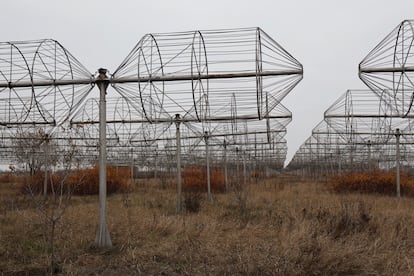40 kilometers from the front in Ukraine is the largest low-frequency radio telescope in the world. Its technical name is UTR-2, and to the untrained eye, its more than 2,000 antennas and diamond shape might resemble a giant art installation. But UTR-2 was a Soviet astronomical project to decipher the formation of galaxies. Half a century after it came into operation, the Russian invasion left it disconnected from the stars.
Igor Bubnov was one of the astronomers at UTR-2 until Russian troops occupied it in the winter of 2022. In the following summer’s counteroffensive in the Kharkiv region, the Ukrainian army liberated the radio telescope. However, the fighting had damaged its infrastructure. Its facilities are in the heart of a war zone and are too close to the enemy, Bubnov says, so restarting them would be senseless.
Bubnov failed to return to UTR-2 and transferred his position to URAN-2, another low-frequency radio telescope built by the USSR in the 1970s, this one located in the Poltava region, 60 miles from the Russian border. Bubnov and his colleagues at the National Institute of Radio Astronomy of Ukraine continue to operate from URAN-2 and two other telescopes in the Volhynia region (in the west, near Poland) and the Odessa region, collecting data (detecting radio waves emitted by celestial bodies) that help decipher the mysteries of galaxies and the solar system. On February 24, 2022, when Vladimir Putin ordered the invasion of Ukraine, UTR-2 was aimed at Jupiter.
URAN-2 is located on the edge of a village made up of some old farms in traditional Ukrainian style. Its 512 antennas capture the electromagnetic radiation of celestial bodies and also the concert that a group of geese performs for visitors. Astronomers sleep on folding cots in the administration building of the radio telescope. In one of the flowerbeds at the entrance they keep beehives to produce honey, and on the other side of the antenna field there is a forest where they collect mushrooms.
The tranquility of the place is ideal for the operation of such sensitive technology, even if the war makes the work of science much more difficult. First, explains Rostislav Vaschishin, Bubnov’s fellow astronomer, there is the problem that the geolocation system is deactivated several times a day. It happens all over Ukraine: when the air raid siren sounds for the arrival of long-range Russian drones, the GPS stops working to prevent the unmanned vehicle from continuing its course towards its target.
This means, for example, that thousands of motorists in Ukrainian cities suddenly lose the signal on traffic maps or that Ukrainian radio telescopes fail to synchronize. Radio telescopes across Europe collaborate by pointing their antennas towards a specific point in the universe. Without the GPS signal, URAN-2 cannot operate in sync.
Other drawbacks of war for astronomers are periodic power outages and the fact that the radio spectrum is saturated with signals, both from drones and from radio-electronic weapons trying to disrupt the connection of unmanned vehicles.
“Despite everything, at least we shouldn’t be a direct target for the Russians; our antennas have no military use,” adds Bubsov, “although perhaps some observation drone pilots believe they are a new anti-aircraft weapon and attack them.”
youth exodus
The worst thing, they say, is the mass exodus of young people during the war. Millions of minors and tens of thousands of Ukrainians of university age, perhaps even of scientific age, have left the country. Last August, President Volodymyr Zelenskiy allowed Ukrainian men between the ages of 18 and 22 to cross the border to study abroad. The result was an exodus of people in this age group, mainly to avoid military service.
“It is becoming increasingly difficult for scientists to graduate from our universities,” says Bubsov. This researcher reveals that the average monthly salary of the staff of the National Institute of Radio Astronomy of Ukraine barely reaches 175 dollars: “The minimum wage in our country is 8,000 hryvnias ($190) per month, but the administration forces you to take sabbaticals in order to pay less.” Bubsov, 48, who holds a senior position, earns about $350 a month. “Why would anyone want to become an astronomer in Ukraine?” Vaschishin complains.
Vaschishin’s dream is to concentrate as much as possible on the study of the hydrogen line, 21 centimeters long, which marked the birth of the first stars after the Big Bang. “Since I won’t be able to live off my pension if I retire,” quips the 58-year-old scientist, “I will continue to work for the rest of my life.”

Vaschishin believes that people “never look at the sky”. He admits that it’s a strange feeling to study galaxies and be aware of how small a human being is while people are killing each other everywhere. “After all, we are all atoms; each individual is a universe in itself,” emphasizes his colleague Bubsov. “We are no different from the rest of the universe; everything is an endless process of creation and destruction,” agrees Vaschishin. “Human society is killing itself the same way the sun will one day destroy our planet.”
Studying the stars in the midst of war invites us to reflect on existence. But the matter is seen differently if you are a soldier in Kharkiv province, like the one guarding the UTR-2 perimeter on November 7: “The Big Bang is not the kind of explosion that interests me right now.”
Sign up to our weekly newsletter to get more English-language news coverage from EL PAÍS USA Edition



